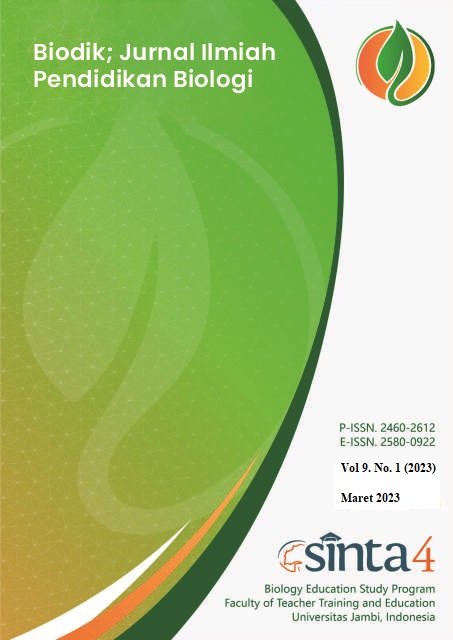Penerapan Strategi Pembelajaran Reciprocal Learning untuk Meningkatkan Hasil Belajar Siswa di SMA Negeri 1 Pancur Batu
(Application Of Reciprocal Learning Strategy to Increase Student Learning Outcomes In Sma Negeri 1 Pancur Batu)
DOI:
https://doi.org/10.22437/bio.v9i1.19186Abstract
This research is a classroom action research conducted in two cycles. Each cycle consists of planning, implementation, observation and observation. The subjects of this study were students of class X MIA SMA Negeri 1 Pancur Batu Academic year 2021 / 2022. This study aims to determine the improvement in learning outcomes of class X MIA students in Biology subjects through learning strategies (Reciprocal Learning). The instruments used are observation, pretest and posttest. Student observation sheet The indicator of the success of this study is seen from the mastery of student learning who achieves the Minimum Completeness Criteria (KKM) of 80. From the results of the study, in the first cycle the student learning completeness achieved is 75%, and the second cycle is 85%, where the increase the percentage of student learning outcomes from cycle I to cycle II reached 10%. Based on the results of this study, it can be concluded that student learning outcomes in Biology can be increased through Reciprocal Learning learning strategies, and have the advantage of developing student knowledge, forming collaboration between students and creating student curiosity, especially in the environment around the school at SMA Negeri 1 Pancur Batu.
Key words: Classroom Action Research, student learning outcomes, Reciprocal Learning Model
Â
ABSTRAK
Eksplorasi ini merupakan penelitian kegiatan hasil studi yang diarahkan dalam dua siklus. Setiap siklus terdiri dari penyusunan, pelaksanaan, persepsi dan persepsi. Subyek review ini adalah siswa kelas X MIA SMA Negeri 1 Pancur Batu tahun ajaran 2021/2022. Review ini berencana untuk memutuskan peningkatan hasil belajar siswa kelas X MIA pada mata pelajaran Biologi melalui teknik pembelajaran (Reciprocal Learning). Instrumen yang digunakan adalah persepsi, pretest dan postest. Lembar persepsi siswa kemajuan penelitian ini dilihat dari kewenangan pencapaian siswa yang mencapai Kriteria Ketuntasan Minimal (KKM) 80. Dari hasil review, pada siklus utama pemenuhan pembelajaran siswa yang dicapai adalah 75%. , dan siklus II sebesar 85%, dimana laju pemuaian pada siswa yang memperoleh hasil dari siklus I ke siklus II mencapai 10%.Â
Kata kunci: Penelitian Tindakan Kelas, hasil belajar siswa, Model Pembelajaran Reciprocal
Downloads
References
Agip, et al.(2009).Penelitian Tindakan Kelas untuk Guru. Bandung :Yramaâ€
Dansereau.(1985).Learning Strategi Research. Inj Segal S.Chipman dan R.Bloser Edsâ€
Slameto, (2010). Belajar dan Faktor-faktor yang Mempengaruhinya,Jakarta: Rineka Cipta,cet. 5,hal 2â€
Sudjana, N. (2011.) Penilaian Hasil dan Proses Belajar Mengajar. Bandung:Rosda Karyaâ€
Suyatno. (2009). Menjelajah pembelajaran inovatif. Sidoarjo:Masmedi Buana Pustakaâ€
Tim.Konsorsium.Sertifikasi. (2013). Modull.PLPG.: Ilmu.Pengetahuan Alam. Yogyakarta: Konsorsium Sertfikasi Guru Universitas Negeri Yogyakartaâ€
Kartinah, dan Hery Kresnadi, Syamsiati. 2015. Peningkatan Hasil Belajar Siswa Dalam Pembelajaran Matematika Menggunakan Media Konkret Di Sekolah Dasar.Jurnal Program Studi Pendidikan Dasar FKIP Untan, Pontianakâ€
Trianto. (2007). Model-model Pembelajaran Inovatif Berorientasi Konstruktivistik. Jakarta: Prestasi Pustakaâ€
Kartina dkk. (2015).Peningkatan Hasil Belajar Siswa Dalam Pembelajaran Maemaika Menggunakan Media Konkret Di Sekolah Dasarâ€
Downloads
Published
How to Cite
Issue
Section
License
Copyright (c) 2023 Jeneri Puspita Sari, Halimatussya’diyah, Sauda Julia Intanna, Sauda Julia Intanna, Siti Nurbaya, Indayana Febriani Tanjung

This work is licensed under a Creative Commons Attribution-NonCommercial-ShareAlike 4.0 International License.
Copyright Notice
Authors who publish with Biodik : Jurnal Ilmiah Pendidikan Biologi agree to the following terms:
- For all articles published in Biodik : Jurnal Ilmiah Pendidikan Biologi, copyright is retained by the authors and grant the journal right of first publication with the work simultaneously licensed under a Creative Commons Attribution-ShareAlike 4.0 International Licensethat allows others to share the work with an acknowledgment of the work's authorship and initial publication in this journal.
- Authors are able to enter into separate, additional contractual arrangements for the non-exclusive distribution of the journal's published version of the work (e.g., post it to an institutional repository or publish it in a book), with an acknowledgment of its initial publication in this journal.
- Authors are permitted and encouraged to post their work online (e.g., in institutional repositories or on their website) prior to and during the submission process, as it can lead to productive exchanges, as well as earlier and greater citation of published work (See The Effect of Open Access).
















